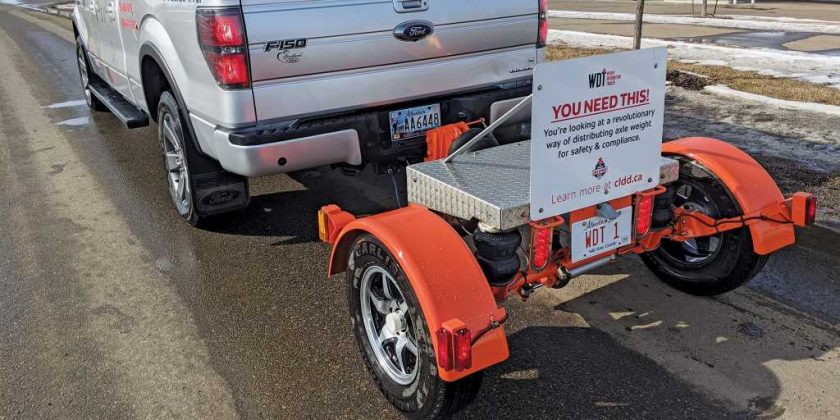Shortly after our long-term Ram 2500 Cummins test truck arrived, I did what manufacturers assume all truck owners will eventually do: I overloaded it. I needed two 3,880-pound pallets of cement to build a seawall. Each one, centered over the truck’s rear axle, exceeded the gross axle weight rating by about 1,150 pounds and the gross vehicle weight rating by about 2,040 (roughly 20 percent in each case). The truck easily managed the short trips I made without incident, but I recently learned of a new device that could have brought it into legal compliance on those runs.
Canadian entrepreneur Lawrence Stross has devised a load-divider dolly “trailer” equipped with three air springs. It rigidly connects to a truck’s Class-III hitch receiver, allowing the dolly to serve as an additional loaded axle with passive steering. Two air springs support the axle and shoulder some of the rear axle’s burden. A third imparts a torque moment between the hitch receiver and the trailer to shift some payload burden to the front axle.
Load-distributing trailer hitches work similarly, but when driven over dips and driveway ramps, the torque on the vehicle can vary. Because an air compressor on the dolly maintains constant pressure in that third airbag, the load-divider dolly maintains more consistent loading of each axle in these conditions.
The design is rated for 1 ton (including the 340-pound dolly). This weight counts as trailer weight and hence applies to the gross combined weight, not the gross vehicle weight. The trailer draws 12-volt power and lighting signals from a standard seven-pin connector.
At 1 ton, trailer brakes are not required, and testing confirms braking distances are well within Canada’s legal maximum. The Ford F-150 used for testing carried 1,938 pounds of ballast distributed to max out the truck’s axle weight ratings. This mass exceeds the GVWR by 1,530 pounds but undercuts the gross combined weight rating by a lot. Braking distances from 60 mph measured 189 feet—18 percent longer than the same truck unladen. Stross envisions adding higher-capacity dolly models with trailer brakes in the future. Optimal load distribution improves safety and control while reducing brake, tire, and suspension wear and avoids potentially costly vehicle overload fines.
Setting up the load-divider dolly requires adjusting the attachment point to match the unladen truck’s receiver height and memorizing that setting in the ECU. Then the dolly can be detached for loading, reattached, and set to level the truck and distribute the load.
The dolly’s solid axle trailing arm suspension geometry provides positive caster with the axle springs inflated and negative caster with them deflated and bottomed out. Deflating the bags takes 6.0 seconds and ensures proper passive steering when reversing. The third airbag compensates to maintain weight distribution when reversing.
At 68 inches wide and 64 inches long, the dolly doesn’t impinge on other lanes in tight turns, and at just 35 inches tall, most pickup tailgates can lower without hitting it. You can’t attach additional trailers to the dolly, but Stross has demonstrated towing a fifth-wheel or gooseneck-type trailer using the dolly to redistribute the load. Doing this requires a hitch mounted well aft in the pickup box, 78 inches ahead of the trailer face to clear the dolly.
Stross’ company, Canadian Load Divider Dollies, targets its Weight Distributing Trailer at individuals and fleet operators who only occasionally need to exceed their truck’s GVWR. For example, cube truck repair fleets whose standard equipment load nears the GVWR, with certain heavy replacement parts putting them over; farmers whose half-ton trucks suffice except when transporting harvested crops; or vacationers with heavy pickup-bed campers.
The initial WTD909 load-divider dolly is patented, and the company is ready to produce them. But it is shopping the concept around, looking for an order large enough to get production rolling at a price that will likely range between $5,000 and $7,000 Canadian each, depending on order size. In a perfect world, home-improvement stores would offer load-divider dollies for rent and require their use before knowingly allowing schmoes like me to overload their trucks.
Source: Read Full Article
